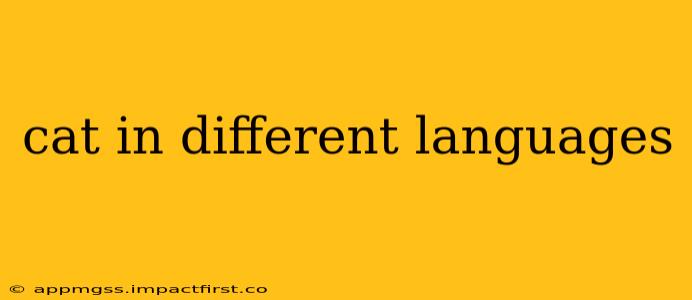Cats. Those fluffy, independent creatures have captured the hearts of humans worldwide for millennia. Their presence in our lives is so significant that their name, naturally, varies across languages and cultures. This exploration dives into the fascinating world of how different languages name these feline friends, revealing some surprising etymologies and cultural nuances along the way.
What is the word for cat in Spanish?
The Spanish word for cat is "gato" (masculine) and "gata" (feminine). This simple yet elegant word is widely understood throughout the Spanish-speaking world, from Mexico to Spain to Argentina. Its pronunciation is relatively straightforward, making it easily accessible for learners. The difference between "gato" and "gata" reflects the grammatical gender assigned to nouns in Spanish, a feature absent in many other languages.
What is the word for cat in French?
In French, the word for cat is "chat." This short, monosyllabic word is just as common and familiar as its Spanish counterpart. Interestingly, "chat" has also lent itself to various slang terms and expressions in French culture, reflecting the animal's long-standing presence in the French imagination.
What are some other languages and their words for "cat"?
Let's broaden our horizons! Here's a glimpse into how other languages refer to our feline companions:
- German: Katze (kat-zeh)
- Italian: Gatto (gat-toh) – similar to Spanish, with a masculine and feminine form (gatta).
- Portuguese: Gato (gah-toh) – again, mirroring Spanish in form and pronunciation.
- Russian: Кот (kot) – a short and distinctive word.
- Japanese: 猫 (neko) – written using Kanji characters.
- Chinese (Mandarin): 猫 (māo) – uses a single character, also phonetically similar to the Japanese word.
- Korean: 고양이 (goyangi) – a longer, more descriptive word.
How did these words for "cat" originate?
Tracing the origins of words for "cat" often leads us back to Proto-Indo-European roots, with various linguistic branches evolving their own variations over time. The similarities between words in Romance languages (Spanish, French, Italian, Portuguese) reflect their shared Latin ancestry. However, the diversity across other language families demonstrates the independent evolution of words to describe this common animal. Detailed etymological research would reveal more specific pathways for each individual language, a topic far more extensive than this brief exploration allows.
Are there different words for cats based on breed or characteristics?
While there aren't separate words to differentiate cat breeds in most languages, colloquialisms and descriptive terms might arise in specific contexts. For example, a large cat might be referred to informally with a descriptive adjective in many languages. However, the core vocabulary remains consistent, focusing on the general term for "cat."
Why are there so many different words for "cat" across languages?
The variety of words for "cat" across languages reflects the independent evolution of languages themselves. As human populations migrated and developed distinct cultures, their languages diversified, leading to unique ways of naming the same animal. This linguistic diversity is a testament to the richness and complexity of human communication. Furthermore, the importance and relationship humans have with cats has varied across different cultures, which has influenced the lexicon used to refer to them.
This exploration only scratches the surface of the vast linguistic landscape surrounding the simple word "cat." Further research into specific language families and their historical development would reveal even richer detail about how our feline friends have been named across the globe.
